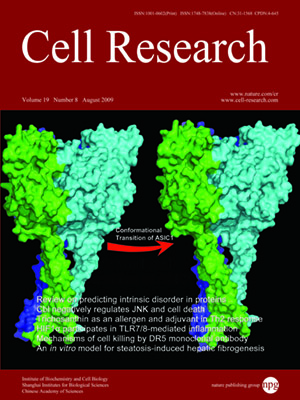
Volume 19, No 8, Aug 2009
ISSN: 1001-0602
EISSN: 1748-7838 2018
impact factor 17.848*
(Clarivate Analytics, 2019)
Volume 19 Issue 8, August 2009: 1018-1130
ORIGINAL ARTICLES
A critical role of PUMA in maintenance of genomic integrity of murine spermatogonial stem cell precursors after genotoxic stress
Anne Forand1,2,3 and J Bernardino-Sgherri1,2,3
1CEA, DSV, iRCM, SCSR, Laboratory of Differentiation and Radiobiology of the Gonads, Fontenay aux Roses F-92265, France
2Université Paris 7 Denis Diderot, Unit of Gametogenesis and Genotoxicity, Fontenay aux Roses F-92265, France
3INSERM, U566, Fontenay aux Roses F-92265, France
Correspondence: J Bernardino-Sgherri,(jacqueline.bernardino@cea.fr )
Neonatal gonocytes are precursors of spermatogonial stem cells. Preserving their integrity by elimination of damaged germ cells may be crucial to avoid the transmission of genetic alterations to progeny. Using γ-irradiation, we investigated by immunohistochemistry, flow cytometry and real-time PCR components of the death machinery in neonatal gonocytes. Their death was correlated with caspase 3 activation but not with AIF translocation into the nucleus. The in vivo contribution of both the extrinsic and the intrinsic pathways was then investigated. We focused on the roles of TRAIL/Death Receptor 5 (DR5) and PUMA. Our results were validated using knockout mice. Whereas DR5 expression was upregulated at the cell surface after radiation, caspase 8 was not activated. However, we detected caspase 9 cleavage associated with cytochrome c release. In mice deficient for PUMA, radiation-induced gonocyte apoptosis was reduced, whereas invalidation of TRAIL had no effect. Overall, our results show that genotoxic stress-induced apoptosis of gonocytes is caspase-dependent and involves almost exclusively the intrinsic pathway. Furthermore, PUMA plays a critical role in the maintenance of genomic integrity of spermatogonial stem cell precursors.
Cell Research (2009) 19:1018-1030. doi: 10.1038/cr.2009.50; published online 5 May 2009
FULL TEXT | PDF
Browse 1916


